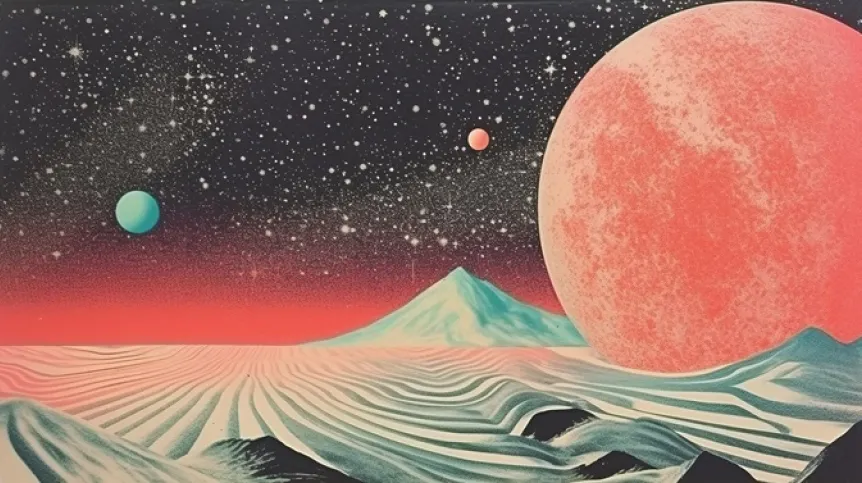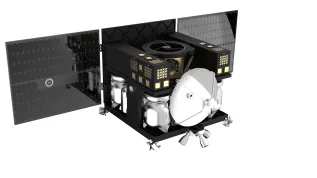
‘Planets form wherever possible and they are very common. Although astronomers already know over 5,000 extrasolar planets, called exoplanets for short - we are still surprised by their diversity and the differences between most planetary systems and our parent system, the Solar System,’ says astronomer Dr. Grzegorz Nowak from the Nicolaus Copernicus University in Toruń.
With the help of the American TESS (Transiting Exoplanet Survey Satellite) and the European Cheops (CHAracterising ExOPlanet Satellite), scientists recently discovered and described the unique planetary system HD110067, 100 light-years from the Sun, located in Coma Berenices. Its six planets are in the so-called resonance, which is one of the reasons why it is a particularly interesting system for researchers.
'Resonance is a fairly simple matter. In this particular case of the six planets around HD110067 we label +b+ through +g+, if the planet closest to the star, which we label +b+, makes three orbits - then the next planet in order, which we label +c+, makes two orbits. We then say that planets +b+ and +c+ are in a 3:2 resonance. The same resonance occurs between planets +c+ and +d+ and +d+ and +e+. A 4:3 resonance exists between planets +e+ and +f+, and +f+ and +g+. Additionally, between planets +b+ and +g+, i.e. the first and last from the star, there is a 1:6 resonance - planet +b+ needs only 9 days to orbit the star, and planet +g+ needs 54 days. As astronomers, we expect that planetary systems form in such a resonance configuration. So if we see it, it means that we are observing a system that has been preserved in an undisturbed form for billions of years - in the same way it was born,’ explains Dr. Nowak from the Institute of Astronomy at the Nicolaus Copernicus University.
'The physics of these planets themselves is also interesting and important. Measurements of radii and masses tell us that they are so-called mini-Neptunes. In terms of size (radii), they are between Neptune (four times larger than Earth) and planets are twice as large as Earth. The assessment of the density of these planets shows that their internal structure is more similar to Neptune. We expect that their cores are surrounded by a layer of gases dominated by hydrogen. Future research conducted, for example, with the James Webb Space Telescope (JWST), may allow us to determine the composition of their atmospheres and thus better understand the process of their formation and internal structures,’ says the astronomer who studies exoplanets, including their masses and atmospheres. He also participated in the study of the six resonance planets mentioned above.
'That system of planets is one of the systems discovered by the NASA's TESS mission, which detects so-called transits, i.e. passages of planets against the background of the discs of their host stars. However, after such detection, it is necessary to repeat the observation of the so-called transit curve using ground-based instruments and conduct its detailed analysis. This allows us to determine whether we are actually dealing with a planet or another phenomenon. The final step of ground-based observations is using of precise spectrographs, which allow us to break down the light of the star around which the planets orbit into individual colours and thus measure their radial velocity and determine the masses of the orbiting planets. Since 2014, we have been conducting this type of research at the Canary Astrophysical Institute (Instituto de Astrofísica de Canarias - IAC), initially examining planets discovered as part of the NASA's Kepler mission, and later as part of the TESS mission. Rafael Luque, currently working at the University of Chicago, whom I co-supervised, proposed examining the HD110067 system. In 2020, we completed the first measurements of the radial velocity of this star,’ Nowak says.
However, there were obstacles. 'Our initial research, instead of providing an answer, only complicated the whole picture. Nevertheless, we decided to carry out further work and decisive information was obtained thanks to the Cheops satellite,’ the astronomer adds.
Cheops is a space observatory with special capabilities.
'It is a small European satellite whose mission is a continuation of the COROT (Convection Rotation and Planetary Transits) programme. However, unlike COROT or Kepler, Cheops does not focus on long-term surveys of individual parts of the sky, but instead monitors selected stars for a more detailed study of transits of previously discovered planets, as well as searching for transits of potential additional planets in these systems. Cheops was able to detect transits where we expected them - and indicate which of the scenarios we predicted for this system was true,’ says Dr. Nowak.
Over 5,000 confirmed extrasolar planets are already known, but it is difficult to talk about routine in their research.
'I think that astronomers are surprised by both the diversity of planets and the differences between most planetary systems and our Solar System. At the same time, they may be surprised by their commonness. On average - according to what we have already discovered - there is one planet per star. So, in simple terms, we can say that planets form wherever possible,’ says Nowak.
He adds that exoplanet research is still developing: 'I think that the astronomy of extrasolar planets is currently experiencing a similar stage to that experienced by stellar astronomy several decades ago. At that time, attempts were made to understand how stars form and evolve. At that time, astronomers were particularly interested in binary systems, which were the easiest to determine the masses and radii of their stars. Now, in the case of planets, the aforementioned method - observations of transits conducted with space telescopes and ground-based telescopes - allows us to detect new planets and, knowing the radii of the stars, determine the radii of the planets. With ground-based telescopes equipped with precise spectrographs, we can measure the radial velocity of the star that the planets orbit - that is, determine how much the planets gravitationally affect their host star, which, in turn, allows us to determine their masses. Knowing the mass and radius of the planet, we can easily calculate its average density, and this can tell us a lot about its structure - whether we are dealing with a rocky planet such as Venus, Earth or Mars, or perhaps a gas giant such as Jupiter or Saturn, or an ice giant similar to Neptune and Uranus.’

Moreover, the planet's past can also be assessed.
'Whether planets are close to the star and have short orbital periods, or the opposite, says a lot about their formation. For example, a planet's gas envelope can only form at a greater distance from the star, beyond the so-called snow line, because at close range the volatile material is blown away by the stellar wind. So, if a large planet with a gaseous envelope is close to a star, it means that it has wandered to this place from a greater distance. Astronomers have already managed to understand a lot, but they are now also looking for systems such as HD110067 that have retained their original shape,’ Dr. Nowak continues.
Much of our understanding of the sky has changed since the launch of the James Webb Space Telescope.
'JWST operating in space has a mirror with a diameter of 6 m. We expect that in the case of planets the size of Earth, we will be able to study the atmospheres only of those globes that orbit the smallest stars - much smaller than the Sun, for example in the TRAPPIST-1 system, in which seven rocky planets orbit a red dwarf. The star of this system is only slightly larger than Jupiter (but it is over 90 times more massive). However, JWST is best suited for studying larger planets, at least 2-3 times larger than Earth. This was also one of the goals of the TESS mission - to detect sub-Neptunian planets that could be studied with Webb. In the system we study, we have 6 planets that are ideally suited for this purpose,’ says Nowak.
Astronomers are also waiting for new instruments.
'The new ground-based observatories will have even greater power. Telescopes such as the Extremely Large Telescope (ELT), with its 39-meter-diameter mirror, will even allow us to study the atmospheres of Earth-sized planets orbiting the nearest Sun-like stars. It will also be possible to detect and study the atmospheres of planets that do not undergo transits - i.e. they are not located in our line of sight and do not pass in front of the star. With the help of these instruments, it will be possible to separate the image of the star from the image of the planets, Now continues.
He adds: ‘We might even find traces of life. What is needed is the simultaneous detection of oxygen, carbon dioxide and methane, which strongly supports the activity of living organisms, and not only geological processes that can also emit these gases. Finding this combination of chemical compounds can be a strong argument for the existence of a biosphere on a given planet.’ (PAP)
PAP - Science in Poland, Marek Matacz
mat/ zan/ kap/
tr. RL













